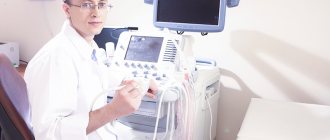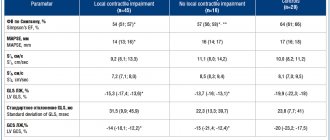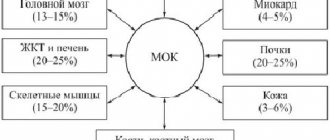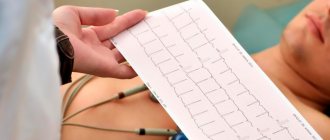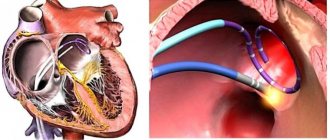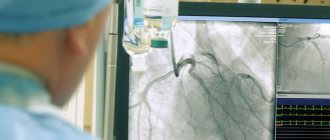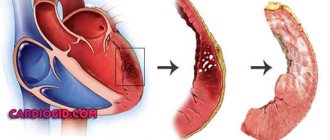Sign up
+7
Echocardiography in combination with Doppler sonography is a non-invasive, extremely effective diagnostic method aimed at assessing the condition of the heart and blood vessels. The study allows you to evaluate in detail the contractility of individual parts of the heart muscle and the organ as a whole, study the functioning of the ventricles, the structure of the valve apparatus, visualize the movement of blood and assess the functionality of the blood flow. Echocardiography and Doppler make it possible to identify complex pathologies of the cardiovascular system, making it possible to eliminate them with minimal risk of complications.
What is a cardiac echo?
Echocardiography is the leading method for diagnosing pathologies of the cardiovascular system.
High information content, safety for humans and relatively low price of cardiac ultrasound (compared to other types of diagnostics) are the three main parameters due to which the method has become widespread. Cardiac echocardiography is a non-invasive ultrasound diagnostic method. During the examination, the doctor, in real time, evaluates the activity, size and structure of all structures of the heart:
- heart muscles,
- chambers (atria and ventricles),
- valve apparatus,
- walls,
- main vessels.
Using an ultrasound examination of the heart, a doctor can confirm or exclude many pathologies of the heart and large vessels in both children and adults:
- acquired congenital heart defects,
- post-infarction cardiosclerosis,
- atrial fibrillation,
- heart tumors,
- intracavitary thrombi,
- hypertension,
- ischemic disease,
- valve damage, etc.
The expectant mother needs to undergo fetal echocardiography if:
- there was a predisposition to heart defects in the family;
- the previous pregnancy ended in spontaneous miscarriage;
- she suffers from endocrinological diseases (diabetes mellitus, hypothyroidism, thyrotoxicosis);
- took strong drugs during pregnancy (antibiotics and antiepileptic drugs or other drugs);
- suffered infectious diseases during pregnancy (rubella, influenza or herpes);
- was exposed to the harmful effects of radiation and exposure;
Echocardiography with Doppler analysis
In our center, in addition to standard echoCG (one-dimensional and two-dimensional), with which the doctor can identify heart pathologies, echocardiography with Doppler analysis is performed. Our equipment allows us to perform an advanced assessment of the functioning of the heart and great vessels using the following techniques:
- pulsed wave dopplerography
. Serves to assess the pumping function of the heart. Allows you to record the clicks of opening and closing valves. Registers the speed of blood flow in the valves and great vessels;
- continuous wave Dopplerography.
Allows you to measure high blood flow velocities. Also serves to calculate pressure in large vessels and cavities of the heart in different phases of the cardiac cycle;
- color dopplerography
. Allows you to evaluate not only the speed, but also the direction of blood movement through the main vessels. Used to assess pathological blood flow through the heart valves.
What does an ultrasound show?
Sonography is used in medicine both for diagnosing various diseases and for visual monitoring of complex surgical interventions.
The scope of application of ultrasound includes the study of:
- abdominal organs;
- thyroid gland;
- heart (echocardiography);
- vessels (carotid arteries or veins of the legs);
- mammary glands;
- uterus, ovaries (including during pregnancy);
- joints, such as the hip.
There are two types of ultrasound: diagnostic and therapeutic. Diagnostic ultrasound creates images using high-frequency sound waves generated by a transducer (probe). But for better visualization, the ultrasound head can also be inserted into the body through the gastrointestinal tract, vagina or blood vessels.
Therapeutic ultrasound also works with sound waves, but does not generate images. It is used to move and apply pressure to tissue, heat it, dissolve blood clots, or administer medications. Standard ultrasound has no harmful effects.
Abdomen
It is used both for diagnosing diseases and for monitoring the course of pathological processes in the body. Used to evaluate the condition of various organs, such as the liver, kidneys and spleen. The doctor determines the structure, size and location of the bladder, gallbladder and pancreas.
Limited assessment of bowel health is possible. It is also possible to detect free fluid in the abdominal cavity, such as inflammatory effusion or blood.
Thyroid
It is possible to determine the structure, size and focal formations. Scanning allows you to identify problems at the initial stages of progression, which makes it possible to begin treatment in a timely manner - before complications develop. Ultrasound of the thyroid gland is the most accessible and informative research method that can be performed as many times as necessary without harm to the patient’s health.
Echocardiography
Typically, an echo examination of the heart is performed like any other ultrasound, that is, using a sensor that the doctor moves over the surface of the patient’s body. When diagnosing the heart, transesophageal (TEE - transesophageal) echocardiography can be performed. The doctor pushes a special probe through the esophagus to the entrance to the stomach. The heart is in close proximity and can therefore be examined better.
Doppler ultrasound
A comprehensive study aimed at determining the anatomical structure, nature, speed of blood flow and condition of the vascular walls (tension, elasticity). Allows you to identify damage to vascular structures, congenital anomalies and pathological tortuosity. Visualizes atherosclerotic changes, blood flow disorders, aneurysms and occlusions, as well as inflammatory processes and thrombophlebitis.
Ultrasound of female breast
A painless examination is the “gold standard” for the prevention of breast diseases. Allows you to examine all areas of glandular tissue, much more informative than with radiography and mammography. Using breast sonography, it is possible to identify various pathological changes: cysts and tumors, as well as assess the condition of the lymph nodes.
Gynecological ultrasound
Sonography of the pelvic organs is prescribed to evaluate ongoing therapy in gynecology or to identify pathological changes in the uterus, appendages, etc. Gynecological ultrasound reveals the fact of pregnancy, fetal development abnormalities and pathological disorders in the reproductive health of a woman.
Sonography of joints
Aimed at studying the condition of soft tissues and bone structures to identify pathological foci and prescribe effective therapy. Ultrasound of joints is performed for congenital anomalies, after injuries and to diagnose degenerative or inflammatory diseases. The diagnostic procedure does not replace radiography of the joint, since it does not allow assessing the displacement, the presence of fragments and the nature of the fracture.
Indications for echocardiography (echocardiography)
Diseases of the cardiovascular system in both children and adults can often develop without symptoms. In order to notice in time and prevent the development of a minor pathology into a serious disease, it is recommended to undergo echocardiography once a year. If the following symptoms occur, a study is required:
- acute pain in the heart and chest;
- feeling of lack of air and shortness of breath;
- dizziness;
- loss of consciousness;
- swelling of the legs;
- frequent bluishness of the skin: ears, hands and fingers, around the lips;
- fast fatiguability;
- heart rhythm disturbances and detection of noise during listening;
- frequent headaches;
- hypertonic disease;
- atherosclerosis.
An ultrasound of the heart of a child under one year of age is most often performed on the direction of a cardiologist or therapist. It is given when noise is detected during listening or if one of the immediate family suffers from severe cardiac diseases. In addition, it is recommended to perform an ultrasound of the child’s heart in the following cases:
- the baby weakly sucks the breast;
- there is blueness around the mouth and nose when crying and sucking;
- with stunted growth and weight gain;
- with increased sweating.
For older children, echocardiography (echoCG) is prescribed if the child:
- often suffers from pneumonia,
- loses consciousness
- complains of pain in the heart area,
- gets tired quickly.
The price of echocardiography for adults and children is the same.
When is a cardiac ultrasound prescribed?
Main indications for cardiac ultrasound:
- scheduled examination. It is carried out for newborn children to identify defects and congenital anomalies, for adolescents - to detect functional disorders, for pregnant women, athletes and people at risk or with chronic disorders of the cardiovascular system;
- frequent exacerbation of tonsillitis, rheumatic fever, scarlet fever, toxic tissue damage. These conditions can lead to the development of myocardial diseases and require regular examination and monitoring of the body;
- assessment of heart function after installation of an artificial pacemaker, cardiac surgery and drug therapy;
- presence of heart disease. Ultrasound is performed for arrhythmia, ischemic heart disease, heart failure, cardiomyopathy and other diseases;
An ultrasound of the child’s heart is performed as part of a routine medical examination. The study is prescribed in the first months of life to identify early congenital and acquired defects, heart failure, myocarditis, endocarditis and other pathologies. Parents can suspect the development of heart pathology in a newborn by the characteristic blue discoloration of the skin in the area of the nasolabial triangle, significant weight loss, pallor of the skin, severe shortness of breath and lethargy. During the period of intensive growth and increased load on the child’s myocardium, it is recommended that adolescents aged 10–15 years undergo echocardiography for preventive purposes.
Our patients have access to intrauterine ultrasound diagnostics. Experts suggest pregnant women undergo fetal echocardiography - fetal echocardiography. The study is prescribed for suspected congenital heart defects of the unborn child, cardiac dysfunction, chromosomal abnormalities and intrauterine infections. If one of the parents has a defect, fetal echocardiography is performed at 18–22 weeks of pregnancy.
Indications for intrauterine ultrasound diagnosis of a child are the use of drugs by a woman with a pronounced teratogenic effect, the presence of serious diseases in the expectant mother, in particular systemic lupus erythematosus, diabetes mellitus, arthritis and cardiovascular pathologies.
How is cardiac echocardiography performed?
In our clinic or directly at the patient’s home, tests are carried out only by certified diagnosticians specializing in cardiovascular diseases. Thanks to their extensive experience and special training, they are well aware of how the structures of the heart are displayed on an echocardiogram, normally and in the presence of pathologies.
The procedure for echocardiography and ultrasound of the heart vessels (Dopplerography), performed at home or in the clinic, is simple and does not require special training. During the examination, the patient is placed on the couch on his back or left side. The doctor, using a special sensor, scans the heart in various positions to obtain images of all its parts and surrounding vessels.
After the procedure, a conclusion is issued. Depending on what the ultrasound of the heart shows, the doctor may prescribe additional studies and tests.
Preparing for the study
Although most ultrasound examinations do not require preparation, there are a few exceptions:
- before an ultrasound of the gallbladder, the patient is asked not to eat or drink anything 6 hours before the procedure;
- a full bladder may be required during pelvic ultrasound;
- to improve image clarity, a harmless substance called contrast agent is injected before the examination;
- If necessary, intravenous tranquilizers are used.
Young children may require additional preparation for an ultrasound. We are talking about the use of sedatives to prevent the child from being overly active during the procedure.
How is the stress echo CG procedure performed?
At the CBCP clinic, stress echocardiography is performed in two ways:
- using horizontal and vertical bicycle ergometers;
- using special stimulant drugs.
The study is carried out under the supervision of certified and experienced specialists:
- a cardiologist with special training in performing stress tests;
- diagnostician working in the field of stress echocardiography and cardiac ultrasound.
First, the patient, who is at rest, undergoes echocardiography and records the indicators. After which the body is exposed to strictly calculated physical activity or medicinal stimulants. Doctors monitor changes in the well-being and functional state of the patient’s heart, processing the results using a computer.
Stress echo CG makes it possible to obtain images of the heart at various stages of the examination. The indicators recorded under load are analyzed and compared with the indicators at rest.
Contraindications and preparation for cardiac ultrasound
There are no contraindications for echocardiography, with the exception of serious damage to the skin on the anterior surface of the chest, in which case the examination will have to be postponed while the integrity of the skin is restored. Obtaining high-quality examination results may be affected by the characteristics of the patient himself, for example, the large size of the mammary glands in women, a strong cough in a patient with lung diseases and a smoker, or significant deformation of the chest will cause some difficulties, but this is not an indication for refusing the examination.
The conditions for performing an ultrasound of the heart are the most minimal - you should not overeat three hours before the procedure so that the high position of the diaphragm does not interfere with the examination.
The chest will be smeared with a special gel for ideal contact of the sensor with the surface of the skin, sending ultrasonic waves. During ECHO CG of the heart, an adult patient, and even more so a child, can move and talk - this will not affect the results of the examination. If necessary, the doctor will ask you not to talk.
Benefits of stress echocardiography
Stress echo CG is a safe study that can be repeated as many times as necessary. Highly sensitive equipment is highly informative and detects even asymptomatic abnormalities in the heart.
This method also makes it possible to:
- diagnose silent myocardial ischemia and angina pectoris;
- assess heart rate;
- determine the viability of the myocardium after a heart attack;
- identify blood flow disorders;
- record changes in blood pressure at rest and after exercise.
Our advantages
Ultrasound diagnostics at Alfa Health Center has the following advantages:
- the use of modern ultrasound machines during cardiac echocardiography. Research is carried out using high-quality equipment from world leaders - General Electric. Diagnostics is highly informative and clear, takes little time and is comfortable for the patient;
- the opportunity to carry out additional procedures in the clinic. During the examination, it is often necessary to expand the diagnosis, seek advice from specialized specialists (cardiologists, therapists, endocrinologists) - in our centers, patients have access to comprehensive services at reasonable prices;
- high information content. Using ultrasound, you can determine the size of the cavities, the thickness of the heart walls, the functioning of the valves, blood flow and hemodynamics. The method makes it possible to detect cardiac diseases at an early stage, including in children, starting from the first days of life. Decoding the norm of echocardiography is used to make an accurate diagnosis, select treatment, prevent the development of complications and relapses of chronic pathologies.
Interpretation of cardiac ultrasound results
The results of the study are interpreted using an echocardiograph. Diagnostics provides information on more than 100 indicators of heart condition.
After the procedure, you will receive a transcript of the study results. Do not attempt to independently analyze the data obtained, much less draw conclusions about the use of any medications. This is especially true for ultrasound data of a child. Only a cardiologist can accurately and correctly interpret the obtained indicators.
Doctors at the CBCP clinic will explain to you in detail the meaning of the parameters indicated in the report and make an objective diagnosis. You will receive further recommendations regarding treatment and a prognosis of your health situation.
Benefits of echocardiography (echoCG) at the CBCP clinic
Cardiac ultrasound, both directly at the CBCP clinic and at the patient’s home, is performed using modern equipment by highly qualified specialists. Our doctors have extensive experience in conducting functional studies, as well as certificates confirming successful training in ultrasound diagnostics in the field of cardiology. The clinic uses additional research methods to make the most accurate diagnosis.
You can get detailed information on heart ultrasound for adults and children (including at home), as well as echocardiography with Doppler analysis in Moscow, the price of the procedure and the possibility of making an appointment by calling, or by leaving a request on the website.
In what cases is it carried out?
The method allows you to see the heart, blood vessels, and blood flow. Transthoracic ECHO-CG is performed on patients if there are indications:
- Acute coronary syndrome.
- Cardiomyopathy.
- Heart failure.
- Ischemic disease.
- Pulmonary hypertension, the nature of which is not clear.
- Myocarditis.
- Thromboembolism in the pulmonary artery.
- Endocarditis of an infectious nature.
- Heart defects, congenital and acquired.
- Syncope.
Echocardiography using Doppler is used to examine patients before surgery, to evaluate the effectiveness of therapy, and as a control for patients who have relatives with serious cardiac pathologies.
Make an appointment with a specialist without queues, at a convenient time
Sign up
+7
On-site diagnostics at home
The basic package includes the following services:
| Name of service | Price, rub.) |
| Basic complex | |
| Preliminary consultation with a cardiologist | |
| ECG 12 leads with interpretation | |
| EchoCG (ultrasound of the heart) | |
| Final consultation with a cardiologist with selection of therapy and recommendations | |
| Within the Moscow Ring Road cost | 10 000 |
| Outside the Moscow Ring Road (cost of one kilometer) | 150 |
Re-departure of the team*:
- consultation with a cardiologist - 5,000 rubles
- consultation + ECG with interpretation - 6000 rubles
- consultation + echocardiography (ultrasound of the heart) - 8000 rubles
* outside the Moscow Ring Road the cost of one kilometer is 150 rubles.
